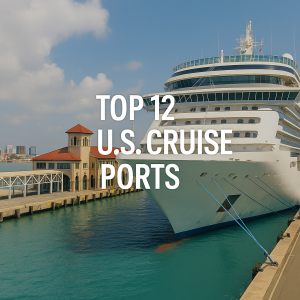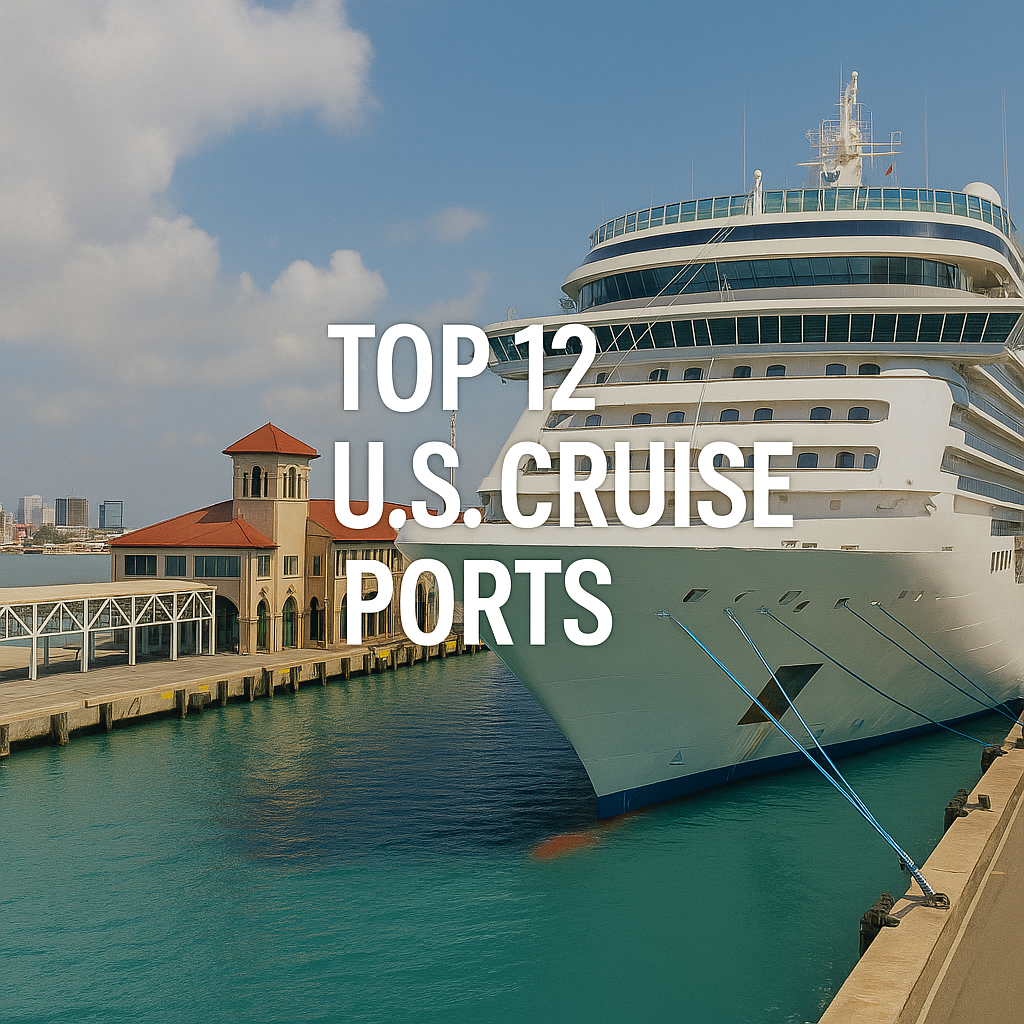Discover the top 12 U.S. cruise ports that drive tourism, boost the economy, and support maritime innovation. Explore their infrastructure, traffic statistics, and their evolving role in sustainable cruise operations.

Why U.S. Cruise Ports Matter in Modern Maritime Operations
Cruise ports are more than just gateways to exotic vacations—they are critical nodes in the maritime economy. The U.S. cruise industry generated over $50 billion in economic activity in 2023, supporting more than 400,000 jobs across port cities (CLIA, 2024). These ports support not only tourism but also ship repair, provisioning, fuel bunkering, regulatory inspections, and intermodal logistics.
Cruise ports are also advancing sustainability, resilience, and passenger safety—key priorities aligned with the International Maritime Organization’s (IMO) MARPOL Annex VI emissions standards and port state control enforcement.
From the sun-drenched terminals of Florida to the rugged Pacific coast of Seattle, here are the top 12 cruise ports that anchor the U.S. position as a global leader in passenger shipping.
1. PortMiami (Florida) – “Cruise Capital of the World”
Handling over 7.3 million passengers in 2023, PortMiami is the world’s busiest cruise port. It serves as the homeport for major cruise lines like Carnival, Royal Caribbean, MSC, and Norwegian.
Developments:
PortMiami has invested over $1 billion in new terminals and shore power infrastructure, in line with IMO decarbonization efforts.
Notable Ships: Symphony of the Seas, Norwegian Prima
Website: miamidade.gov/portmiami
2. Port Canaveral (Florida)
A major launch point for cruises to the Bahamas and Eastern Caribbean, Port Canaveral handled 6.8 million passengers in 2023. Its proximity to Orlando boosts its tourist appeal.
Technology:
The port is testing LNG bunkering systems for new vessels like Carnival’s Mardi Gras, aligning with IMO GHG targets.
Website: portcanaveral.com
3. Port Everglades (Fort Lauderdale, Florida)
Serving more than 3.5 million cruise passengers in 2023, Port Everglades is renowned for its efficient embarkation systems and international reach.
Green Innovation:
Shore power installation and terminal electrification underway in collaboration with Florida Power & Light and Wärtsilä.
Website: porteverglades.net
4. Port of Galveston (Texas)
Galveston is the fastest-growing cruise port in the U.S., with over 1.4 million passengers in 2023. It supports itineraries to Mexico and Central America and has become Royal Caribbean’s primary Gulf Coast base.
Expansion:
$125 million Royal Caribbean terminal opened in 2022, designed with LEED Gold standards and solar energy integration.
Website: portofgalveston.com
5. Port of Los Angeles (California)
Though better known for cargo, the Port of Los Angeles handled over 1 million cruise passengers in 2023. It is the primary gateway for Pacific Coast and Mexican Riviera cruises.
Sustainability Focus:
In partnership with the California Air Resources Board (CARB), the port mandates 80% shore power use for cruise vessels as of 2023.
Website: portoflosangeles.org
6. Port of New Orleans (Louisiana)
A vital southern embarkation point, Port NOLA handled over 1.2 million cruise passengers in 2023. Its location offers unique access to Mississippi River cruises and Caribbean routes.
Multimodal Integration:
Direct rail access and inland waterway connections enhance cruise provisioning and crew logistics.
Website: portnola.com
7. Port of Seattle (Washington)
Seattle is a major embarkation port for Alaskan cruises, serving over 1.7 million passengers annually. Its terminals accommodate ships like the Norwegian Encore and Ovation of the Seas.
Green Shipping Initiatives:
Seattle has partnered with the Vancouver Fraser Port Authority and Alaska ports to create the first green corridor for cruise ships.
Website: portseattle.org
8. Port of San Diego (California)
Handling roughly 300,000 passengers annually, San Diego focuses on smaller, luxury, and expedition-class vessels. It is also involved in homeporting cruise ships during seasonal fluctuations.
Environmental Leadership:
Award-winning shore power system reduces over 90% of at-berth cruise ship emissions.
Website: portofsandiego.org
9. Port of New York and New Jersey
With cruise terminals in both Manhattan and Brooklyn, this port handles over 1.5 million passengers annually and is the main East Coast gateway to Europe and Canada/New England itineraries.
Resilience Planning:
Post-Hurricane Sandy improvements include elevated terminals and upgraded drainage systems.
Website: panynj.gov
10. Port of Tampa Bay (Florida)
Though smaller than other Florida ports, Tampa Bay serves 1 million passengers annually and connects directly to western Caribbean routes.
Accessibility:
Close proximity to Tampa International Airport and downtown tourism boosts its appeal for weekend cruisers.
Website: porttb.com
11. Port of Charleston (South Carolina)
With a modest but steady passenger volume (~250,000 annually), Charleston is a key cultural port offering historical and coastal experiences.
Controversies and Solutions:
Facing pressure from local communities over emissions and congestion, the port has proposed new environmental controls and cruise schedule limitations.
Website: scspa.com
12. Port of Baltimore (Maryland)
Baltimore offers year-round cruise departures to the Bahamas and Caribbean, serving over 300,000 passengers annually. It benefits from proximity to Washington D.C. and major East Coast corridors.
Dredging and Terminal Upgrades:
Recent $100M terminal expansion project aims to support next-gen vessels and autonomous security systems.
Website: marylandports.com
–
Real-World Application: The Rise of LNG Cruise Ships
Ports like PortMiami and Port Canaveral have adapted quickly to accommodate LNG-powered cruise ships such as Carnival’s Mardi Gras and MSC’s World Europa. This transition requires new bunkering systems, safety protocols, and compliance with IMO IGF Code standards. These advancements demonstrate how U.S. ports are leading the charge in maritime energy transitions.
FAQ Section
1. What is the busiest cruise port in the U.S.?
PortMiami holds the title, with over 7.3 million passengers handled annually.
2. Which cruise ports support LNG bunkering?
Port Canaveral and PortMiami are currently equipped for LNG bunkering, with others planning infrastructure upgrades.
3. Are U.S. cruise ports implementing shore power systems?
Yes. Ports like Seattle, Los Angeles, and San Diego have operational shore power systems that reduce emissions during docked operations.
4. What is a “green corridor” in cruising?
A green corridor is a route between ports optimized for reduced emissions using technologies like LNG, biofuels, or electric propulsion.
5. How are ports preparing for larger cruise ships?
Through dredging, terminal expansions, and structural reinforcements to accommodate post-Panamax vessels.
6. Which port is best for Alaskan cruises?
Seattle is the leading homeport for Alaskan cruise itineraries.
7. Do ports follow IMO regulations?
Yes, U.S. cruise ports comply with IMO regulations on safety, emissions (MARPOL), and passenger vessel inspection (SOLAS compliance).
Conclusion
U.S. cruise ports are not merely logistical checkpoints; they are engines of economic development, environmental stewardship, and maritime innovation. From LNG transitions and shore power adoption to multimodal efficiency and tourism integration, these ports are aligning closely with the future of sustainable maritime operations. As the cruise sector rebounds post-pandemic, these ports are ready to accommodate not just more passengers—but smarter, greener vessels.
Call to Action:
Whether you’re a maritime student, policy advisor, or cruise line executive, explore the development strategies of these ports. Visit their websites, follow their sustainability initiatives, or contribute to maritime infrastructure research.
References
-
Cruise Lines International Association (CLIA). https://cruising.org
-
IMO GHG Strategy. https://www.imo.org/en/OurWork/Environment/Pages/GHG-Emissions.aspx
-
Wärtsilä LNG Systems. https://www.wartsila.com
-
PortMiami. https://www.miamidade.gov/portmiami/
-
Port Canaveral. https://www.portcanaveral.com
-
U.S. Coast Guard Port State Control Reports. https://www.uscg.mil
-
MarineTraffic Cruise Vessel Tracker. https://www.marinetraffic.com
-
DNV Maritime Decarbonization Reports. https://www.dnv.com/maritime

